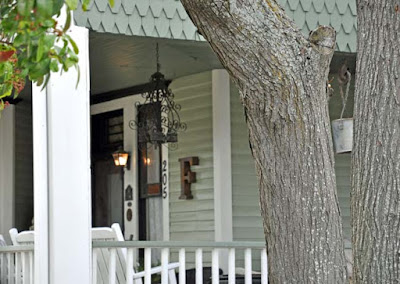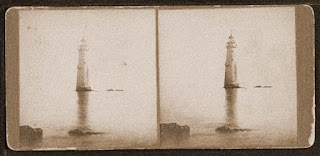Some people have no honor and will break promises without a second thought. Other people will try to keep their promises, yet still fall short. But there are some who will go to great lengths to keep their promises. For some, even death cannot prevent them from fulfilling a sacred promise.
The Hardin House is a lovely old house built in 1838. It was the home of William Hardin, a prominent politician in the Pittsboro, North Carolina area. The house has always been known for its beautiful grounds, especially the manicured backyard which gently slopes down to a picturesque spring. It was here in the late spring of 1839 that a promise was made between two young lovers.
William Hardin's daughter, Helen, was to be wed in June to Philip Jones, a young, hard-working area planter who everyone said had a bright future ahead of him. Just a few weeks before their wedding day, the two lovers met one evening at the spring to discuss their wedding plans. The night was warm, the air was filled with the sweet smell of flowers and the moon was full in the starlit sky. Philip waited beside the cool water until Helen came out of the house wearing a beautiful, flowing white dress. As the moonbeams flashed through her hair, she hurried down to be with her love.
When she reached him, Philip took her into his arms and said "You're just like an angel. Promise me you'll stay just the way you are tonight". Helen blushed and shyly promised that she would. Philip and Helen spent the evening talking of the parties that were to be thrown, Helen's dress for the wedding that belonged to her grandmother and Philip's work on the house he was building where they would raise a family and live out their lives. Time seemed to stand still, but all too soon, Helen's father called her home for bed. The two shared a lingering embrace before parting ways. Philip stood beside the water and watched his love run back up the hill. It was the last time he would ever see her alive.
That night, Helen fell into a sleep from which she never awoke. The doctor said it was a heart attack. Philip was devastated. In his anguish, he returned to the spring every evening and waited for Helen to come running down the hill. People in the town talked and worried about him. Then one moonlit night that fall, a local preacher new to the area told of riding by and seeing a young man and a girl with golden hair in a white dress standing beside the spring behind the Hardin's house. He inquired as to who it was as he knew the family did not have a daughter. As time went on, Philip continued to come to the spring on nights when the moon was full and there were many who told of seeing him standing close to a beautiful girl in a white dress.
Philip devoted himself to his work and became very successful, but he never married. He lived his whole life in the house he had built with his own hands in 1839. The Hardin House has changed owners several times, but people totally unfamiliar with the history still report seeing the ghost of Helen Hardin dressed in white with the moonlight shining through her golden hair, running down the slope of the back yard before vanishing beside the spring. She had made a promise, you see. A promise she has kept.
The Hardin House is a lovely old house built in 1838. It was the home of William Hardin, a prominent politician in the Pittsboro, North Carolina area. The house has always been known for its beautiful grounds, especially the manicured backyard which gently slopes down to a picturesque spring. It was here in the late spring of 1839 that a promise was made between two young lovers.
William Hardin's daughter, Helen, was to be wed in June to Philip Jones, a young, hard-working area planter who everyone said had a bright future ahead of him. Just a few weeks before their wedding day, the two lovers met one evening at the spring to discuss their wedding plans. The night was warm, the air was filled with the sweet smell of flowers and the moon was full in the starlit sky. Philip waited beside the cool water until Helen came out of the house wearing a beautiful, flowing white dress. As the moonbeams flashed through her hair, she hurried down to be with her love.
When she reached him, Philip took her into his arms and said "You're just like an angel. Promise me you'll stay just the way you are tonight". Helen blushed and shyly promised that she would. Philip and Helen spent the evening talking of the parties that were to be thrown, Helen's dress for the wedding that belonged to her grandmother and Philip's work on the house he was building where they would raise a family and live out their lives. Time seemed to stand still, but all too soon, Helen's father called her home for bed. The two shared a lingering embrace before parting ways. Philip stood beside the water and watched his love run back up the hill. It was the last time he would ever see her alive.
That night, Helen fell into a sleep from which she never awoke. The doctor said it was a heart attack. Philip was devastated. In his anguish, he returned to the spring every evening and waited for Helen to come running down the hill. People in the town talked and worried about him. Then one moonlit night that fall, a local preacher new to the area told of riding by and seeing a young man and a girl with golden hair in a white dress standing beside the spring behind the Hardin's house. He inquired as to who it was as he knew the family did not have a daughter. As time went on, Philip continued to come to the spring on nights when the moon was full and there were many who told of seeing him standing close to a beautiful girl in a white dress.
Philip devoted himself to his work and became very successful, but he never married. He lived his whole life in the house he had built with his own hands in 1839. The Hardin House has changed owners several times, but people totally unfamiliar with the history still report seeing the ghost of Helen Hardin dressed in white with the moonlight shining through her golden hair, running down the slope of the back yard before vanishing beside the spring. She had made a promise, you see. A promise she has kept.


























